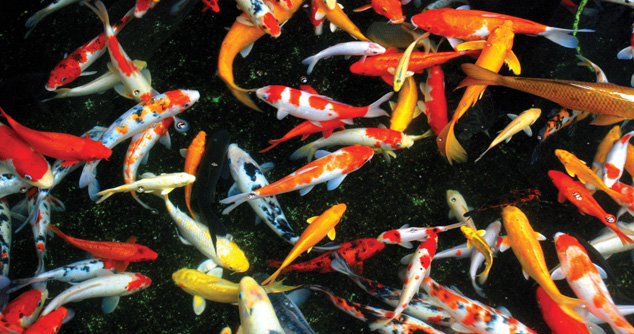A harsh winter in some locations coupled with little or no preventative care could be a recipe for disaster as ponds thaw out in the spring. Weather is an important factor in any season for causing a localized fish kill. If lethargic fish near the surface are seen “gulping for air” an emergency situation exists and requires immediate attention. The larger adult fish are typically the first to die when oxygen levels are low since their oxygen needs are higher. To protect their investments, pond owners need to take preventative measures to guard against shifts in weather, over-vegetation and other factors that contribute to what causes fish kills.
Wintertime Fish Kill
Animal metabolism and oxygen consumption are greatly reduced in cold water. Cold water is able to retain more dissolved oxygen than warm water. Therefore, in a typical pond there is sufficient oxygen contained in the water to support fish life.
Wintertime fish kill is often the result of a steady decrease in oxygen during a long period of ice cover. In early winter the body of water is saturated with oxygen and wind at the surface created a continuous mixing that keeps oxygen and temperatures uniform. In mid-winter ice can begin to form, eliminating the mixing and oxygen transfer of the open water. The sole source of oxygen becomes the small amount produced by the few remaining algae and plants. While greatly reduced, oxygen contribution from photosynthesis is still possible as long as the ice is thin enough to allow sunlight to permeate through. A more critical problem develops late into harsh winters where the ice thickens considerably or is covered by dense snow.
The greater the volume of water in a pond the less likely the chance of winterkill. More water simply translates to more available oxygen. Dead, decaying aquatic vegetation is another significant factor in ponds that experience winterkill. A pond bottom covered with these materials will have a reduced oxygen supply as bacteria attempt to break down the material producing gases that can be toxic to fish. If the pond has a high fish load the effects of reduced oxygen are amplified.
As long as the pond is open or partially open, oxygen levels will likely remain sufficient during winter months. Natural oxygen levels can quickly rebound during a warm period of two to three days if ice buildup is reduced. A diffused aeration system is the single most important preventative measure that a pond owner can take against winterkill. Aeration not only directly adds oxygen, but the boiling action it created is often able to keep a hole in the ice and reduce overall ice buildup.
Summertime Fish Kill
Oxygen production due to photosynthesis is highest during the summer. Warm water and long hours of daylight maximize the amount of oxygen producing algae and plants. However, the respiratory processes of animal, plant and bacteria are also at their highest levels at this time. As long as daytime oxygen production outpaces nighttime consumption a summertime fish kill due to oxygen will not occur.
Many ponds can become choked with vegetation during summer months, which doesn’t directly cause a fish kill. Issues may arise in ponds with excessive vegetation during a period of hot, calm and cloudy days. Just like a pond surface covered in heavy ice and snow, a substantial reduction of sunlight reduces oxygen production.
Herbicides and algaecides can indirectly affect fish populations depending on the amount and type of vegetation being treated. When excessive aquatic vegetation is treated late in the season, the simultaneous die off can create a substantial build up of decaying organic matter. This breakdown requires massive amounts of oxygen to process. Additionally, the vegetation is often the major contributor of new oxygen into the body of water.
A summer pond can become stratified, meaning warm upper layers sit on top of separate and distinct cold bottom layers. The oxygen rich upper layer is sufficiently mixed by wind while the bottom most layers may be completely devoid of oxygen by late summer. Cold water is denser than warm water, therefore drops to the bottom of the pond. If a stratified body of water is suddenly mixed by a weather event such as heavy cold rain the result may be a large fish kill.
As long as the amount of vegetation is in balance with the aquatic life a fish kill can be avoided; the prevention of a summertime fish kill is closely related to wintertime prevention. Again, the best method to prevent fish kills is to install an aeration system to mix and add oxygen to the pond.

